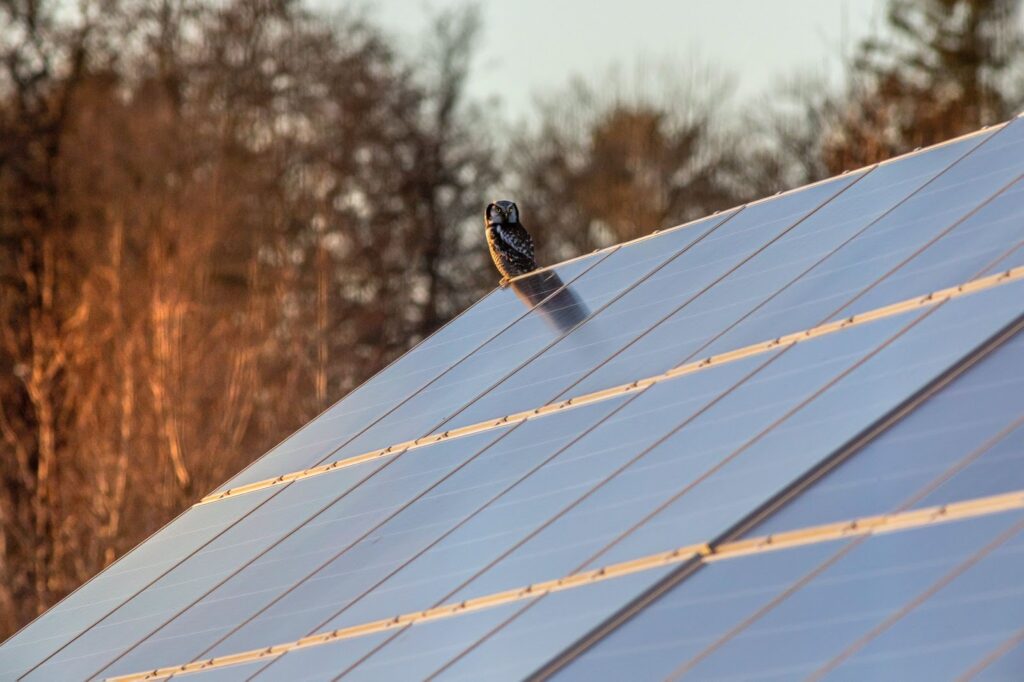
Thin-film panels are one of the most exciting solar panel technologies to hit the market.
While crystalline solar panels are thought to have pretty much achieved their highest possible efficiency rates, thin-film panels have the potential to be developed into something extremely versatile and efficient.
Thin-film panels may not currently be the best option for commercial applications, but they very well could be in the future. That’s why we’re watching their development closely.
Here’s what you need to know about them.
In a Nutshell
- Thin-film solar panels are the simplest and cheapest type of panel to manufacture.
- Cadmium Telluride is the most popular type of thin-film panel, but it can be toxic.
- Average efficiency rates of thin-film panels range between 7% – 18%.
- At around 10 – 20 years, the lifespan of a thin-film panel is shorter than traditional panels.
- The cost of a thin-film panel is $1 – $1.50 per watt.
- Thin-film panels can be integrated into buildings and building materials.
- Gallium Arsenide panels have broken the world record for efficiency but you’ll only find them in space or the military.
Thin Film Solar Panel Features at a Glance
| Thin film panel type | Average warranty | Average lifespan | Efficiency rate | Watt capacity |
| Cadmium Telluride (CdTe) | 10 – 25 years | 25 – 30 years | 10% – 11% average | 90 – 130 watts (per square meter) |
| Copper Indium Gallium Selenide (CIGS) | 10 – 25 years | 20 – 30 years | Up to 18% | 150 – 190 watts (per square meter) |
| Amorphous Silicone (a-Si) | 10 – 20 years | 5 – 10 years | Up to 7% | 50 – 80 watts (per square meter) |
The average cost of a thin film solar panel ranges between $1.00 – $1.50 per watt with a 10kW system costing between $10,000 – $15,000.
What Are Thin Film Solar Panels?
Thin film solar panels are an exciting development that has the potential to revolutionize the solar landscape. Unlike traditional solar panels that are large, rigid, and heavy, thin film solar panels are small, lightweight, incredibly thin, and flexible.
This gives them the unique ability to mold into different shapes and be installed in a wide variety of places. Additionally, they are easily integrated into other materials, such as window panes, roofs, and even vehicles.
This has paved the way for solar and construction to become integrated, which opens up exciting opportunities for energy-efficient and sustainable building development.
However, despite being incredibly versatile, thin film solar panels have a distinct disadvantage when compared to their traditional counterparts, which is that they are a lot less efficient at harvesting the sun’s energy.
How Are Thin Film Solar Panels Made?

There are several different types of thin film solar panels available that we have outlined below, but the manufacturing process is roughly the same.
The base of the panel – called the “substrate” – generally consists of a sheet of polyamide, glass, or metal. Aluminium is the preferred material overall because it serves to improve conductivity and helps prevent energy loss while being cheap to source and manufacture.
Next comes the semiconductive layer. This can be either:
- Cadmium Telluride
- Copper, Indium, Gallium, and Selenide
- Amorphous silicon
- Organic polymers
- Gallium Arsenide
Finally, a protective layer of glass or clear polyamide is laid over the top and a semi-conductor film is also applied. Unlike traditional solar panels, no framing component is required.
This is by far the easiest way to manufacture solar panels and the simple process affords a lot of versatility. For example, thin-film solar panels can be made transparent (for window applications) and they can be made with varying degrees of flexibility, which means they can bend and form into a desired shape.
It’s also important to note that thin-film panels are manufactured in a continuous roll that can be cut to size. The typical height of the panel is 15.5 inches and the thickness is only 0.2 inches. The length of the roll depends on the manufacturer and the needs of the customer.
How Do Thin Film Solar Panels Work?
Thin film solar panels work in the same way as traditional panels – they harvest the light that hits their surface and transform it into an electrical current.
When light photons reach the semi-conductor materials within the panel, they react with the atoms and free the electrons contained within. These electrons bounce around and form the electrical current which passes through to the electrical circuitry attached to each panel.
The generated electricity can be used immediately, it can flow into and charge a battery, or flow into the grid and be exchanged for energy credits.
How Well Do Thin Film Solar Panels Perform?
The biggest drawback of thin-film solar panels is the reduced amount of efficiency when compared with their crystalline counterparts. The type of photovoltaic material used does make a difference, though, and depending on which one is used, the panels can achieve efficiencies ranging between 7% – 18%.
The lower the efficiency of the panels, the more is needed to achieve the desired output, but since they can be installed in all manner of places, they can still be very effective in areas with limited space.
Additionally, their composition is more delicate than rigid solar panels and they are more prone to damage and cracking. As such, their lifespans are shorter and tend to only last between 10 – 20 years.
Also, they are not as tolerant of overly hot or cold temperatures, making them unsuitable for climates that regularly experience extreme weather conditions.
What Types of Thin Film Solar Panels Are Available?
We’ve already touched on the different types of thin-film solar panels. Some are readily available on the commercial market, while others are reserved for specialist applications or are an emerging technology.
Cadmium Telluride (CdTe) Panels

First, let’s take a look at the CdTe panel, which is the most widely used, with around 50% of thin-film panels manufactured using these materials. This is because they are very cheap to manufacture while providing reasonable efficiency.
Cadmium telluride has a potential efficiency rate of up to 18%, but commercially available CdTe panels are more likely to achieve rates of 10% – 11%.
The biggest problem with CdTe panels is that Cadmium is one of the most toxic heavy metals in existence and has the ability to cause great harm to people, animals, and the surrounding environment.
If the panels are properly maintained and cared for, they remain safe and do not usually present a concern. However, if they are damaged and left unrepaired, or if they are improperly disposed of, then this is when serious issues can arise.
Copper Indium Gallium Selenide (CIGS) Panels

CIGS panels offer a far less toxic alternative to CdTe panels. They are created using separate layers of copper, indium, gallium, and selenide, which are laid on top of one another to create a pretty powerful semiconductor.
CIGS have a better efficiency rate that can reach around 18% depending on the quality of the brand of panel. Panels tested in lab conditions have even reached efficiency rates of over 23%, which makes it a promising alternative to crystalline panels.
The downside? CIGS panels cost far more than CdTe panels to produce, which is why they haven’t yet surpassed Cadmium panels in popularity.
Additionally, the multiple layers used to create the panels produce a less flexible result. While you can still bend them to a degree, they are overall less versatile than other thin-film panel types.
On the other hand, CIGS panels don’t always contain toxic materials, making them a safer and more suitable alternative for residential applications. However, bear in mind that some manufacturers add Cadmium to CIGS panels, so they can be toxic although it is now, thankfully, becoming more popular to replace the Cadmium element with Zinc.
For example, solar shingles (where shingle-shaped solar panels are used to create a roof rather than laying solar panels on top of an existing roof) are most commonly created from CIGS.
Amorphous Silicon (a-Si) Panels
While this is a type of silicon, instead of being created from solid silicon like traditional solar panels are, non-crystalline silicon (C-Si) is deposited onto a glass, plastic, or metal substrate.
The end result is something extremely flexible and the strip of silicon resembles a thin rubber-like strip that is thinner than a strand of human hair. a-Si solar panels are, therefore, very lightweight and versatile and don’t contain any toxic chemicals or metals.
The problem with a-Si is its efficiency rate, which sits around 7%. Overall, it’s the least efficient out of all panel types, although it remains the second-most popular thin-film panel after CdTe because it was one of the earliest developed technologies.
You won’t find a-Si panels on residential or commercial buildings, but you will find them commonly used in portable applications, such as calculators, power banks, and chargers. It’s also widely used in consumer electronics and other devices.
Organic Photovoltaics (OPV)

OPV panels are a relatively new development that provides a 100% non-toxic alternative. Created using organic polymers and molecules, OPV panels can achieve an efficiency rating of about 11%, placing them on par with CdTe panels.
OPV panels are paving the way in the building-integrated photovoltaic market thanks to their incredible versatility. They can be made in a variety of colors, be completely transparent, and be integrated into other building materials.
As such, a lot of research is being poured into how this technology can achieve higher efficiency rates as well as increase their short ten-year (on average) lifespan. Unfortunately, the organic nature of OPV panels means they are quick to degrade – something that doesn’t happen as fast with inorganic modules.
But it will be worth it as OPV has the potential to completely transform the way our buildings and infrastructure generate energy.
Gallium Arsenide (GaAs)

GaAs panels are the wonder kid of solar panel technology. They have incredible properties and efficiency rates that far surpass even the most efficient crystalline solar panels.
GaAs panels are made from a compound of Gallium and Arsenic, which form cubed lattices 1 – 2 microns thick. These lattices are “grown” on a GaAs wafer and then removed and used in the solar panel. The GaAs wafer is then reused to create more layers.
Here’s the brilliant part, GaAs panels have the highest recorded efficiency rates in the world. A triple junction GaAs panel can reach 37% efficiency, while the average efficiency sits at around 30%!
This thin-film panel even holds a world record for its efficiency, it’s extremely flexible and lightweight, performs well in low light, and has a high resistance to moisture, radiation, and UV light.
Why are we not using this super duper technology everywhere?
It costs an absolute bomb to manufacture.
As such, NASA and the military are generally the only industries that get to use GaAs solar panels. For example, in 2021, The International Space Station was treated to an upgrade of triple-junction GaAs panels.
So while the technology is cool, it’s unlikely to become commercially available anytime soon.
The Pros and Cons of Thin Film Solar Panels
| Thin film solar panel pros | Thin film solar panel cons |
| – Very easy and low-cost to manufacture – Flexible and versatile and can be installed just about anywhere – Can be transparent, created in different colors, or integrated into buildings for a discreet or aesthetically pleasing result – Non-toxic panel types are available – Organic thin film presents exciting opportunities for applications as the technology develops | – Lower efficiency rates than traditional crystalline panels – More panels are required to achieve the desired output – Less tolerant of extreme temperatures – Shorter lifespan of around 10 – 20 years – More prone to damage and cracking – Some thin film types contain toxic metals and can be dangerous if not properly disposed of |
Should I Buy Thin Film Solar Panels?
If you are looking for solar panels to power your home and/or business operations, then you will likely find that thin-film panels are not presently the most cost-effective option. In most cases, crystalline panels are the more suitable options.
However, if money is no object and you want something aesthetically pleasing, then solar shingles do present a solution. This is particularly true if you want to generate electricity for off-grid guesthouses or lodges used for tourism.
It’s definitely worth keeping a close eye on how this technology improves in the coming years.
A lot of money, time, and effort is being poured into the research and development of thin film panels, so we expect that there will be some exciting advancements to look forward to in the not-so-distant future.
Talk to 8760 Solar
If you have questions about the different solar panel types, then we have answers!
At 8760 Solar, we have trusted experts in providing solar solutions for farms and agricultural businesses. We can talk to you about the best setup and the best types of solar panels for your business.
If you’re interested in having a chat or receiving a quote for solar then please don’t hesitate to text “READY” to 719 470-0254 or contact us via email: sales@8760solar.com.
We’re looking forward to hearing from you.
Frequently Asked Questions
Are Thin Film Solar Panels Any Good?
Thin-film solar panels offer a better-looking, flexible, and versatile alternative to crystalline solar panels. However, they are less efficient (between 7% – 18%) so you need more of them to generate the desired amount of electricity.
What Is the Lifespan of Thin Film Solar Panels?
The lifespan of thin-film solar panels is shorter than crystalline panels. On average, a thin-film panel will last between 10 – 20 years. Organic voltaic thin-film panels are an emerging technology but the key concern is their particularly short lifespan, which is only about ten years.
What Is the Highest Efficiency Thin-Film Solar Cell?
The thin-film solar cell with the highest efficiency is gallium arsenide, as it can reach efficiency rates of up to 37%. However, these panels are extremely expensive to manufacture, so you will only find them used in the space and military industries.
Copper Indium Gallium Selenide (CIGS) are the most efficient commercially available panel, reaching rates of up to 18%.
What Is the Disadvantage of Thin Film Solar Panel?
Thin film solar panels have the disadvantage of a lower efficiency rate than crystalline panels. Additionally, they have a lower tolerance to extreme temperatures, shorter lifespans, and are more prone to damage.
Are Thin Film Solar Cells Expensive?
Thin-film solar panels cost around $1 – $1.50 per watt. While they are not hugely expensive, they have a lower output and longevity than other panel types, which means more panels are required to achieve the desired output or it will take longer to get a return on investment.
